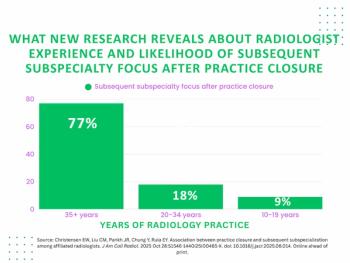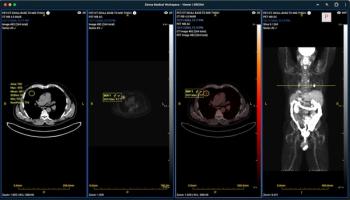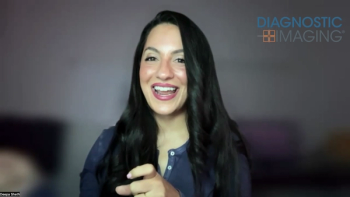
Face-to-Face Conversations Good for Patients, Radiologists
Pilot projects show benefits from radiologists’ in-person communication and patient engagement, signaling that it’s time to work outside of the reading room.
Whether you realize it or not, most patients want to talk with you about their imaging results as soon as possible – they just don’t often mention it. Maybe they’re scared. Maybe they’re nervous. Maybe they think you’re not accessible. Whatever the reason, it’s time to beef-up patient-radiologist communication, according to industry experts.
In recent years, improved communication between patient and provider has become a hot-button topic. Radiologists have lined both sides of the fence, arguing over whether such face-to-face conversations are appropriate. During this time, though, it’s become clear that patients not only want communication, it also makes them feel better and more educated.
Existing
“It’s the old mentality of radiology that we’re going to get the final report to the referring physician or that we can’t tell the patient anything because we need to look at the images,” Amber said. “There’s a role for making correct diagnoses and correlating clinically, but it doesn’t feel like we’re doing the best job for the patient when we send them away without any knowledge of the result of the exam.”
And, it’s that changing mentality – along with the discrepancy between patients who want and those who actually ask about imaging results – that prove the industry must do a better job of engaging patients, said Mark Mangano, MD, a diagnostic radiology resident at Massachusetts General Hospital (MGH).
“There’s a fundamental question of what we can do to better serve the patient,” he said. “To improve patient health on bigger levels, we have to look outside the box of what radiologists already do.”
One Hospital’s Answer
To test whether enhancing patient-provider communication is possible, Mangano launched a pilot project with MGH patients who underwent CT scans. In collaboration with a primary care physician, he enrolled 15 patients in a trial consultation clinic. The study focused on patients living with emphysema, ketosis and atherosclerosis.
[[{"type":"media","view_mode":"media_crop","fid":"25617","attributes":{"alt":"radiologist hiding behind X-ray","class":"media-image media-image-right","id":"media_crop_5520811148453","media_crop_h":"0","media_crop_image_style":"-1","media_crop_instance":"2367","media_crop_rotate":"0","media_crop_scale_h":"0","media_crop_scale_w":"0","media_crop_w":"0","media_crop_x":"0","media_crop_y":"0","style":"margin: 1px; border-style: solid; height: 264px; width: 200px; float: right;","title":" ","typeof":"foaf:Image"}}]]
The ultimate goal, he said, was two-fold: to make better patient-radiologist communication commonplace and to use imaging results as a tangible tool for helping patients make lifestyle changes.
“We had an idea in mind of how we could maximize radiology’s value,” Mangano said. “In reading images, you see things that are common to various conditions. If we can use images to convince people these problems exist, then maybe we can help them change their lifestyle or reduce the burden of disease.”
When paired with primary care services, he said, this type of conversation helps radiologists ensure patients understand what their conditions and the associated damages look like.
The consultation clinic set-up was relatively simple. Enrolled patients came for primary care appointments, and if they agreed to talk with a radiologist, they were sent down to the radiology department. Each consultation with Mangano lasted 20 to 30 minutes, including discussion about the patient’s disease, how it affects their body, what those changes look like in imaging studies, as well as an examination of the CT itself. Patients also had the opportunity to ask questions.
“I’ve been surprised that patients don’t realize what actually happens behind the scenes – that there really are radiologists looking at and going through these studies,” he said. “Often, patients don’t identify radiologists as doctors. But if we sit down and explain things, show them what we do and what we can offer, we can convince patients of what we can do for them.”
For example, Mangano said, with patients who have atherosclerosis, he would identify any calcifications, explain what they were, and make a 3D reconstruction to show the patient what their arteries look like. In addition, he would put the patient’s condition in context of what could happen next – stroke or heart attack – if he or she didn’t make lifestyle changes.
“Patients typically want to know how they fit in. They want context about what they can do and what the outcomes will be,” he said. “There are a lot of things they can’t control, but they can eat a healthy diet, exercise, work with their primary care physician, and take their medications. The focus of the consultation clinic is to show them the changes in their bodies and what could be.”
Challenges
As popular an idea as improved patient-provider communication is, there are still challenges to making it a reality, Mangano said.
Face-to-face conversations are an outside-the-box concept, so getting buy-in from your colleagues could take some time and convincing. It can be tough to carve out time in an already busy workday to staff a consultation clinic. He recommends any new clinics be staff by residents because it would be easier fitting the responsibility into their schedules. The patient contact could also raise resident job satisfaction. Another possibility to include providers would be an on-call rotation schedule for the consulting clinic on Fridays.
According to Pennsylvania Hospital’s Amber, you should also tread lightly when broaching this topic with your primary care colleagues. Many view revealing imaging study results to the patient as their clinical territory.
“The first thing people generally talk about is not giving a recommendation because they don’t know the particular patient’s history and don’t have a long-standing relationship with him or her,” Amber said. “But, we can tell patients that we’ve read their studies and what we’ve seen. We can answer their questions to the extent of our knowledge and, then, refer them back to their primary provider or a specialist.”
Benefits
Based on patient survey results, both providers and patients benefited from the Mangano’s radiology consultation clinic. All patients indicated they would participate in the clinic again, having gained knowledge and strategies to improve their overall health.
Other existing
The impact on providers was also significant.
“From the radiologist perspective, it was great to connect with patients again. Anyone who takes images knows that talking with patients makes it all real,” Mangano said. “It puts into context what you do and say.”
In the long run, boosting face-to-face contact between patients and radiologists could have a positive financial impact, as well. Under the Affordable Care Act and the accountable care organization model, patient satisfaction plays a direct role in reimbursement levels for providers and facilities.
“If patients want things and they’re not getting them, then that’s an unmet need,” Amber said. “We can’t completely fix that, but this is a start.”
Newsletter
Stay at the forefront of radiology with the Diagnostic Imaging newsletter, delivering the latest news, clinical insights, and imaging advancements for today’s radiologists.






























